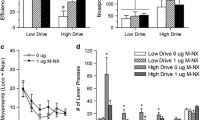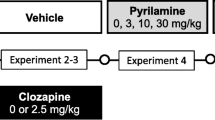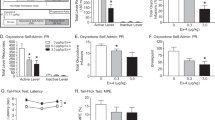Abstract
Rationale
Serotonergic (5-hydroxytryptamine, 5-HT) and opioidergic mechanisms are intimately involved in appetite regulation.
Objectives
In view of recent evidence of positive anorectic interactions between opioid and various non-opioid substrates, our aim was to assess the behavioural specificity of anorectic responses to the opioid receptor antagonist naltrexone, the 5-HT2C/1B receptor agonist mCPP and their combination.
Methods
Behavioural profiling techniques, including the behavioural satiety sequence (BSS), were used to examine acute drug effects in non-deprived male rats tested with palatable mash. Experiment 1 characterised the dose–response profile of mCPP (0.1–3.0 mg/kg), while experiment 2 assessed the effects of combined treatment with a sub-anorectic dose of mCPP (0.1 mg/kg) and one of two low doses of naltrexone (0.1 and 1.0 mg/kg).
Results
Experiment 1 confirmed the dose-dependent anorectic efficacy of mCPP, with robust effects on intake and feeding-related measures observed at 3.0 mg/kg. However, that dose was also associated with other behavioural alterations including increased grooming, reductions in locomotion and sniffing, and disruption of the BSS. In experiment 2, naltrexone dose-dependently reduced food intake and time spent feeding, effects accompanied by a behaviourally selective acceleration in the BSS. However, the addition of 0.1 mg/kg mCPP did not significantly alter the behavioural changes observed in response to either dose of naltrexone given alone.
Conclusions
In contrast to recently reported positive anorectic interactions involving low-dose combinations of opioid receptor antagonists or mCPP with cannabinoid CB1 receptor antagonists, present results would not appear to provide any support for potentially clinically relevant anorectic interactions between opioid and 5-HT2C/1B receptor mechanisms.





Similar content being viewed by others
References
Adan RAH (2013) Mechanisms underlying current and future anti-obesity drugs. TINS 36:133–140
Bagdy G, Makara GB (1995) Paraventricular nucleus controls 5-HT2C receptor-mediated corticosterone and prolactin but not oxytocin and penile erection responses. Eur J Pharmacol 275:301–305
Bagdy G, Kalogeras KT, Szemeredi K (1992) Effect of 5-HT1C and 5-HT2 receptor stimulation on excessive grooming, penile erection and plasma oxytocin concentrations. Eur J Pharmacol 229:9–14
Barnes NM, Sharp T (1999) A review of central 5-HT receptors and their function. Neuropharmacology 38:1083–1152
Basbaum AI, Fields HL (1984) Endogenous pain control systems: brainstem spinal pathways and endorphin circuitry. Annu Rev Neurosci 7:309–338
Beczkowska IW, Bodnar RJ (1991) Naloxone and serotonin receptor subtype antagonists: interactive effects upon deprivation-induced intake. Pharmacol Biochem Behav 38:605–610
Bello NT, Kemm MH, Ofeldt EM, Moran TH (2010) Dose combinations of exendin-4 and salmon calcitonin produce additive and synergistic reductions in food intake in nonhuman primates. Am J Physiol Regul Integr Comp Physiol 299:R945–R952
Benjamin D, Lal H, Meyerson LR (1990) The effects of 5-HT1B characterizing agents in the mouse elevated plus-maze. Life Sci 47:195–203
Berridge KC (2009) ‘Liking’ and ‘wanting’ food rewards: brain substrates and roles in eating disorders. Physiol Behav 97:537–550
Berridge KC, Ho C-Y, Richard JM, DiFeliceantonio AG (2010) The tempted brain eats: pleasure and desire circuits in obesity and eating disorders. Brain Res 1350:43–64
Bhavsar S, Watkins J, Young A (1998) Synergy between amylin and cholecystokinin for inhibition of food intake in mice. Physiol Behav 64:557–561
Bodnar RJ (2004) Endogenous opioids and feeding behavior: a 30-year historical perspective. Peptides 25:697–725
Bojanowska E, Nowak A (2007) Interactions between leptin and exendin-4, a glucagon-like peptide-1 agonist, in the regulation of food intake in the rat. J Physiol Pharmacol 58:349–360
Bojanowska E, Radziszewska E (2011) Combined stimulation of glucagon-like peptide-1 receptor agonist and inhibition of cannabinoid CB1 receptor act synergistically to reduce food intake and body weight in the rat. J Physiol Pharmacol 62:395–402
Boozer CN, Leibel RL, Love RJ, Cha MC, Aronne LJ (2001) Synergy of sibutramine and low dose leptin in treatment of diet-induced obesity in mice. Metabolism 50:889–893
Clifton PG, Barnfield AM, Curzon G (1993) Effects of food deprivation and mCPP treatment on the microstructure of ingestive behaviour in male and female rats. J Psychopharmaol 7:257–264
Clifton PG, Lee MD, Dourish CT (2000) Similarities in the action of Ro 60-0175, a 5-HT2C receptor agonist, and d-amphetamine on feeding patterns in the rat. Psychopharmacology 152:256–267
Cooper SJ, Turkish S (1989) Effects of naltrexone on food preference and concurrent behavioural responses in food deprived rats. Pharmacol Biochem Behav 33:17–20
Cooper SJ, Jackson A, Kirkham TC, Turkish S (1988) Endorphins, opiates and food intake. In: Rodgers RJ, Cooper SJ (eds) Endorphins, opiates and behavioural processes. Wiley, Chichester, pp 143–186
Cowen PJ, Sargent PA, Williams C, Goodall EM, Orlikov AB (1995) Hypophagic, endocrine and subjective responses to m-chlorophenylpiperazine in healthy men and women. Human Psychopharmacol 10:385–391
Day JW, Ottaway N, Patterson JT, Gelfanov V, Smiley D, Gidda J et al (2009) A new glucagon and GLP-1 co-agonist eliminates obesity in rodents. Nat Chem Biol 5:749–757
Dourish CT (1995) Multiple serotonin receptors: opportunities for new treatments for obesity? Obesity Res 3(Suppl 4):449S–462S
Fernandez-Tome MP, Gonzalez Y, Del Rio J (1988) Interaction between opioid agonists or naloxone and 5-HTP on feeding behaviour in food-deprived rats. Pharmacol Biochem Behav 29:387–392
Gadde KM, Allison DB (2009) Combination therapy for obesity and metabolic disease. Expert Opin Pharmacother 10:921–925
Gadde KM, Yonish GM, Foust MS, Wagner HR (2007) Combination therapy of zonisamide and bupropion for weight reduction in obese women: a preliminary, randomized, open-label study. J Clin Psychiatry 68:1226–1229
Garvey WT, Ryan DH, Look M, Gadde KM, Allison DB, Peterson CA et al (2012) Two-year sustained weight loss and metabolic benefits with controlled release phentermine/topiramate in obese and overweight adults (SEQUEL): a randomised, placebo-controlled, phase 3 extension study. Am J Clin Nutr 95:297–308
Giuliano C, Robbins TW, Nathan PJ, Bullmore ET, Everitt BJ (2012) Inhibition of opioid transmission at the μ-opioid receptor prevents both food seeking and binge-like eating. Neuropsychopharmacology 37:2643–2652
Greenway FL, Whitehouse MJ, Guttadauria M, Anderson JW, Atkinson RL, Fujioka K et al (2009) Rational design of a combination medication for the treatment of obesity. Obesity 17:30–39
Griebel G, MIsslin R, Pawlowski M, Vogel E (1991) m-Chlorophenylpiperazine enhances neophobic and anxious behavior in mice. NeuroReport 2:627–629
Hagan MM, Holguin FD, Cabello CE, Hanscom DR, Moss DE (1997) Combined naloxone and fluoxetine on deprivation-induced binge-eating of palatable foods in rats. Pharmacol Biochem Behav 58:1103–1107
Halford JCG, Wanninayake SCD, Blundell JE (1998) Behavioural satiety sequence (BSS) for the diagnosis of drug action on food intake. Pharmacol Biochem Behav 61:159–168
Halford JCG, Harrold JA, Boyland EJ, Lawton CL, Blundell JE (2007) Serotonergic drugs: effects on appetite expression and use for the treatment of obesity. Drugs 67:27–55
Halford JCG, Boyland EJ, Blundell JE et al (2010) Pharmacological management of appetite expression in obesity. Nature Revs Endocrinol 6:255–269
Harrold JA, Dovey TM, Blundell JE, Halford JCG (2012) CNS regulation of appetite. Neuropharmacology 63:3–17
Heal DJ, Gosden J, Smith SL (2012) What is the prognosis for new centrally-acting anti-obesity drugs? Neuropharmacology 63:132–146
Heisler LK, Cowley MA, Tecott LH, Fan W, Low MJ, Smart JL et al (2002) Activation of central melanocortin pathways by fenfluramine. Science 297:609–611
Heisler LK, Cowley MA, Kishi T, Tecott LH, Fan W, Low MJ et al (2003) Central serotonin and melanocortin pathways regulating energy homeostasis. Ann NY Acad Sci 994:169–174
Heisler LK, Jobst EE, Sutton GM, Zhou L, Borok E, Thornton-Jones Z et al (2006) Serotonin reciprocally regulates melanocortin neurons to modulate food intake. Neuron 51:239–249
Hewitt KN, Lee MD, Dourish CT, Clifton PG (2002) Serotonin 2C receptor agonists and the behavioural satiety sequence in mice. Pharmacol Biochem Behav 71:691–700
Higgins GA, Silenicks LB, Robmann A, Rizos Z, Noble K, Soko AD et al (2012) The 5-HT2C receptor agonist lorcaserin reduces nicotine self-administration, discrimination, and reinstatement: relationship to feeding behavior and impulse control. Neuropsychopharmacology 37:1177–1191
Higgins GA, Silenicks LB, Lau W, de Lannoy IAM, Lee DKH, Izakova J et al (2013) Evaluation of chemically diverse 5-HT2C receptor agonists on behaviours motivated by food and nicotine and on side-effect profiles. Psychopharmacology 226:475–490
Hinton V, Rosofsky M, Granger J, Geary N (1986) Combined injection potentiates the satiety effects of pancreatic glucagon, cholecystokinin and bombesin. Brain Res Bull 17:615–619
Hoyer D, Clarke DE, Fozard JR, Hartig PR, Martin GR, Mylecharane EJ et al (1994) International Union of Pharmacology classification of receptors for 5-hydroxytryptamine (serotonin). Pharmacol Rev 46:157–203
Ishii Y, Blundell JE, Halford JCG, Rodgers RJ (2003a) Palatability, food intake and the behavioural satiety sequence in male rats. Physiol Behav 80:37–47
Ishii Y, Blundell JE, Halford JCG, Rodgers RJ (2003b) Effects of systematic variation in presatiation and fasting on the behavioural satiety sequence in male rats. Physiol Behav 79:227–238
Ishii Y, Blundell JE, Halford JCG, Upton N, Porter R, Johns A et al (2004) Differential effects of the selective orexin-1 receptor antagonist SB-334867 and lithium chloride on the behavioural satiety sequence in rats. Physiol Behav 81:129–140
Kennett GA, Clifton PG (2010) New approaches to the pharmacological treatment of obesity: can they break through the efficacy barrier? Pharmacol Biochem Behav 97:63–83
Kennett GA, Curzon G (1988a) Evidence that mCPP may have behavioural effects mediated by central 5-HT1C receptors. Br J Pharmacol 94:137–147
Kennett GA, Curzon G (1988b) Evidence that hypophagia induced by mCPP and TFMPP requires 5-HT1C and 5-HT1B receptors: hypophagia induced by RU 24969 only requires 5-HT1B receptors. Psychopharmacology 96:93–100
Kennett GA, Dourish CT, Curzon G (1987) 5-HT1B agonists induce anorexia at a postsynaptic site. Eur J Pharmacol 141:429–435
Kennett GA, Whitton P, Shah K, Curzon G (1989) Anxiogenic-like effects of mCPP and TFMPP in animal models are opposed by 5-HT1C receptor antagonists. Eur J Pharmacol 164:445–454
Kennett G, Lightowler S, Trail B, Bright F, Bromidge S (2000) Effects or Ro 60-0175, a 5-HT2C receptor agonist, in three animals models of anxiety. Eur J Pharmcol 387:197–204
Kirkham TC, Blundell JE (1984) Dual action of naloxone on feeding revealed by behavioural analysis: separate effects on initiation and termination of eating. Appetite 5:45–52
Kirkham TC, Blundell JE (1986) Effect of naloxone and naltrexone on the development of satiation measured in the runway: comparisons with d-amphetamine and d-fenfluramine. Pharmacol Biochem Behav 25:123–128
Kirkham TC, Blundell JE (1987) Effects of naloxone and naltrexone on meal patterns of freely-feeding rats. Pharmacol Biochem Behav 26:515–520
Kirkham TC, Williams CM (2001) Synergistic effects of opioid and cannabinoid antagonists on food intake. Psychopharmacology 153:267–270
Kitchener SJ, Dourish CT (1994) An examination of the behavioural specificity of hypophagia induced by 5-HT1B, 5-HT1C and 5-HT2 receptor agonists using the post-prandial satiety sequence in rats. Psychopharmacology 113:369–377
Lee MD, Somerville EM, Kennett GA, Dourish CT, Clifton PG (2004) Reduced hypophagic effects of d-fenfluramine and the 5-HT2C receptor agonist mCPP in 5-HT1B receptor knockout mice. Psychopharmacology 176:39–49
Nathan PJ, Bullmore ET (2009) From taste hedonics to motivational drive: central μ-opioid receptors and binge-eating behaviour. Int J Neuropsychopharmacol 12:995–1008
O’Neill PM, Smith SR, Weissman NJ, Fidler MC, Sanchez M, Zhang J et al (2012) Randomized placebo-controlled clinical trial of lorcaserin for weight loss in type 2 diabetes mellitus: the BLOOM-DM study. Obesity 20:1426–1436
Padwal R (2009) Contrave, a bupropion and naltrexone combination therapy for the potential treatment of obesity. Curr Opin Invest Drugs 10:1117–1125
Paulik M, Hamilton B, Hommel J, Holt L, Herring C, Stroup A et al (2011) Combined long-acting PYY and GLP-1 agonism synergistically normalizes weight and glucose in obese and diabetic mice. Diabetes 60:A61, 224-OR
Pietras TA, Rowland NE (2002) Effect of opioid and cannabinoid receptor antagonism on orphanin FQ-induced hyperphagia in rats. Eur J Pharmacol 442:237–239
Ravussin E, Smith SR, Mitchell JA, Ahringarpure R, Shan K, Maier H et al (2009) Enhanced weight loss with pramlintide/metreleptin: an integrated neurohormonal approach to obesity pharmacotherapy. Obesity (Silver Spring) 17:1736–1743
Reidelberger RD, Haver AC, Apenteng BA, Anders KL, Steenson SM (2011) Effects of exendin-4 alone and with peptide YY (3–36) on food intake and body weight in diet-induced obese rats. Obes Silver Spring 19:121–127
Rodgers RJ, Cole JC, Cobain MR, Daly P, Doran PJ, Eells JR et al (1992) Anxiogenic-like effects of fluprazine and eltoprazine in the mouse elevated plus-maze: profile comparisons with 8-OH-DPAT, CGS 12066B, TFMPP and mCPP. Behav Pharmacol 3:621–634
Rodgers RJ, Halford JCG, Nunes de Souza RL, Canto de Souza AL, Piper DC, Arch JRS et al (2001) SB–334867, a selective orexin-1 receptor antagonist, enhances behavioural satiety and blocks the hyperphagic effect of orexin-A in rats. Eur J Neurosci 13:1444–1452
Rodgers RJ, Holch P, Tallett AJ (2010) Behavioural satiety sequence (BSS): separating wheat from chaff in the behavioural pharmacology of appetite. Pharmacol Biochem Behav 97:3–14
Rodgers RJ, Tschöep MH, Wilding JPH (2012) Anti-obesity drugs: past, present and future. Dis Model Mech 5:621–626
Roth JD, Coffey T, Jodka CM, Maier H, Athanacio JR, Mack CM et al (2007) Combination therapy with amylin and peptide YY3-36 in obese rodents: anorexigenic synergy and weight loss additivity. Endocrinology 148:6054–6061
Roth JD, Roland BL, Cole RL, Trevaskis JL, Weyer C, Koda JE et al (2008a) Leptin responsiveness restored by amylin agonism in diet-induced obesity: evidence from nonclinical and clinical studies. Proc Natl Acad Sci U S A 105:7257–7262
Roth JD, Trevaskis JL, Wilson J, Lei C, Athanacio J, Mack C et al (2008b) Antiobesity effects of the beta-cell hormone amylin in combination with phentermine or sibutramine in diet-induced obese rats. Int J Obesity 32:1201–1210
Roth JD, Trevaskis JL, Turek VF, Parkes DG (2010) ‘Weighing in’ on synergy: preclinical research on neurohumoral anti-obesity combinations. Brain Res 1350:86–94
Rowland NE, Mukherjee M, Roberston K (2001) Effects of the cannabinoid receptor antagonist SR141716, alone and in combination with dexfenfluramine or naloxone, on food intake in rats. Psychopharmacology 159:111–116
Samanin R, Mennini T, Ferraris A, Bendotti C, Borsini F, Garattini S (1979) m-Chlorophenylpiperazine: a central serotonin agonist causing powerful anorexia in rats. Naunyn-Schmiedeberg’s Arch Pharmacol 308:159–163
Sargent PA, Sharpley AL, Williams C, Goodall EM, Cowen PJ (1997) 5-HT2C receptor activation decreases appetite and body weight in obese subjects. Psychopharmacology 133:309–312
Simansky KJ, Vaidya AH (1990) Behavioral mechanisms for the anorectic action of serotonin (5-HT) uptake inhibitor sertraline in rats: comparison with directly acting 5-HT agonists. Brain Res Bull 25:953–960
Somerville EM, Horwood JM, Lee MD, Kennett GA, Clifton PG (2007) 5-HT2C receptor activation inhibits appetitive and consummatory components of feeding and increases brain c-fos immunoreactivity in mice. Eur J Neurosci 25:3115–3124
Tallett AJ, Blundell JE, Rodgers RJ (2008a) Behaviourally-selective hypophagic effects of naloxone in non-deprived male rats presented with palatable food. Behav Brain Res 187:417–427
Tallett AJ, Blundell JE, Rodgers RJ (2008b) Endogenous opioids and cannabinoids: system interactions in the regulation of appetite, grooming and scratching. Physiol Behav 94:422–431
Tallett AJ, Blundell JE, Rodgers RJ (2009a) Effects of acute low dose combined treatment with naloxone and AM 251 on food intake, feeding behaviour and weight gain in rats. Pharmacol Biochem Behav 91:358–366
Tallett AJ, Blundell JE, Rodgers RJ (2009b) Night and day: diurnal differences in the behavioural satiety sequence in male rats. Physiol Behav 97:125–130
Tallett AJ, Blundell JE, Rodgers RJ (2010) Sibutramine and naloxone: infra-additive interaction in the regulation of appetite? Behav Brain Res 207:174–181
Talsania T, Anini Y, Siu S, Drucker DJ, Brubaker PL (2005) Peripheral exendin-4 and peptide YY3–36 synergistically reduce food intake through different mechanisms in mice. Endocrinology 146:3748–3756
Vickers SP, Clifton PG (2012) Animal models to explore the effects of CNS drugs on food intake and energy expenditure. Neuropharmacology 63:124–131
Vickers SP, Jackson HC, Cheetham SC (2011) The utility of animal models to evaluate novel anti-obesity agents. Br J Pharmacol 164:1248–1262
Walsh AES, Smith KA, Oldman AD, Williams C, Goodall EM, Cowen PJ (1994) m-Chlorophenylpiperazine decreases food intake in a test meal. Psychopharmacology 116:120–122
Ward SJ, Lefever TW, Jackson C, Tallarida RJ, Walker EA (2008) Effects of cannabinoid1 receptor antagonist and serotonin2C receptor agonist alone and in combination on motivation for palatable food: a dose-addition analysis study in mice. J Pharmacol Exp Ther 325:567–576
Weintraub M, Sundaresan PR, Madan M, Schuster B, Balder A, Lasagna L et al (1992) Long-term weight control study. I (weeks 0–34). The enhancement of behavior modification, caloric restriction, and exercise by fenfluramine plus phentermine versus placebo. Clin Pharmacol Ther 51:586–594
Weiss SM (1995) Pharmacological and behavioural examination of the defensive reactions of laboratory mice to the calls of the Tawny owl. Ph.D. thesis, School of Psychology, University of Leeds (UK)
Weiss GF, Rogacki N, Fuel A, Buchen D, Suh JS, Wong DT et al (1991) Effect of hypothalamic and peripheral fluoxetine injection on natural patterns of macronutrient intake in the rat. Psychopharmacology (Berlin) 195:467–476
Westenberg HGM, den Boer JA (1994) The neuropharmacology of anxiety: a review on the role of serotonin. In: Sitsen JMA, den Boer J (eds) Handbook of anxiety and depression. A biological approach. Marcel Dekker, New York, pp 405–446
Wright FL, Rodgers RJ (2013) Acute behavioural effects of bupropion and naltrexone, alone and in combination, in non-deprived male rats presented with palatable mash. Psychopharmacology. doi:10.1007/s00213-013-3036-6
Young AA (2012) Brainstem sensing of meal-related signals in energy homeostasis. Neuropharmacology 63:31–45
Author information
Authors and Affiliations
Corresponding author
Rights and permissions
About this article
Cite this article
Wright, F.L., Rodgers, R.J. On the behavioural specificity of hypophagia induced in male rats by mCPP, naltrexone, and their combination. Psychopharmacology 231, 787–800 (2014). https://doi.org/10.1007/s00213-013-3295-2
Received:
Accepted:
Published:
Issue Date:
DOI: https://doi.org/10.1007/s00213-013-3295-2




